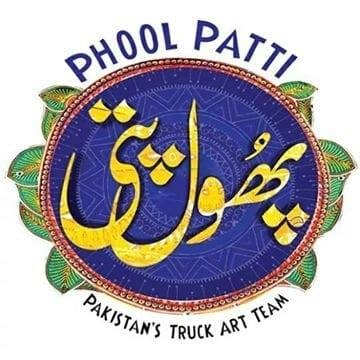In the heart of Pakistan’s cultural truck art lies a vibrant and dynamic form of art and craft field, an expression known for transforming mundane objects into mesmerising works of art, such as truck designs. This art form, which adorns the vehicles of Pakistan, is a significant part of the country’s visual culture. Yet, it remains underappreciated mainly outside its native context. Ali Salman Anchan, the visionary founder of Phool Patti, has taken this traditional form of artistic expression to new heights, merging it with modern sensibilities to create a contemporary platform that continues to celebrate and preserve the legacy of this unique craftsmanship.
Phool Patti has redefined vehicle decoration with its bold, colourful motifs and intricate designs, breathing new life into an art form traditionally restricted to the side panels of trucks, buses, and other commercial vehicles. In doing so, Phool Patti has gained recognition within Pakistan and introduced the world to the mesmerising beauty of Pakistan’s artistic heritage.
A Glimpse into the World of Phool Patti
The name “Phool Patti” draws inspiration from the vibrant floral patterns commonly used in traditional vehicle decoration. In this unique and evolving medium, flowers, geometric shapes, and vivid colours combine to create an eye-catching display of craftsmanship. Historically, vehicle decoration in Pakistan, especially the colourful truck art and buses, was a form of artistic expression meant to represent the driver’s personality, beliefs, and socio-economic status. The vehicles became a canvas, narrating stories and offering glimpses into the cultural diversity of Pakistan.
Phool Patti, however, seeks to break away from the traditional limits of this truck art. Founded by Ali Salman Anchan, a visionary artist with a deep connection to his cultural roots, Phool Patti revitalises this folk art and takes it out of its traditional setting to showcase it in innovative and unexpected ways.
Ali Salman Anchan: The Visionary Behind Phool Patti
Ali Salman Anchan, a passionate and forward-thinking individual, is the driving force behind Phool Patti. His journey began as a deep personal exploration of Pakistan’s artistic traditions, with particular interest in the visual culture surrounding transportation. Raised in a culture where truck art was admired and commonplace, Anchan felt compelled to celebrate and elevate this expression.
Realising the potential to take truck decorations beyond their typical function, Anchan founded Phool Patti to revive the craft and reinterpret it for the modern world. His goal was to create aesthetically pleasing designs and tell a broader story that encapsulated Pakistan’s heritage, spirit, and diversity.
A Modern Twist on Tradition
Phool Patti’s ability to blend tradition with modernity makes it stand out. While the traditional floral and geometric art of truck designs continues to feature prominently, Anchan and his team have expanded the boundaries of the truck craft, incorporating contemporary themes, techniques, and materials to bring truck decoration into the 21st century. This includes using more refined methods, such as high-quality paints, enhanced detailing, and the introduction of new materials like LEDS and reflective surfaces that make the vehicles stand out even more at night.
Moreover, Phool Patti is not confined to just vehicles; it has found its way into home décor, furniture, and fashion. This expanded reach has helped the art form transition from a solely utilitarian aesthetic to a mainstream art movement, admired by a global audience. Reimagining truck decorations as functional art has allowed Phool Patti to gain international recognition and be appreciated by art lovers, interior designers, and collectors.
The Cultural Significance of Phool Patti
Phool Patti’s impact goes beyond the realms of art and design. At its core, it is a movement dedicated to preserving and celebrating Pakistan’s cultural heritage. The vibrant patterns and motifs that define this artistic expression are deeply rooted in the country’s history, representing diverse regions, communities, and their stories.
One of Phool Patti’s primary objectives is to provide a platform for artisans skilled in this age-old craft, ensuring that traditional techniques are passed down to future generations. By reviving this cultural tradition in a modern context, Phool Patti aims to offer economic opportunities to artisans, bring attention to their skills, and celebrate the beauty of handcrafted artistry.
Furthermore, the truck decoration scene in Pakistan is not merely an art form but a symbol of the people’s resilience and creativity. By embracing this cultural practice, Phool Patti helps elevate the status of this art form, fostering a sense of pride in Pakistan’s cultural identity.
How Phool Patti Is Revolutionising the Artistic Landscape
While Phool Patti draws heavily from traditional truck decorations, its approach to incorporating contemporary influences and global design trends truly sets it apart. Anchan’s vision involves making this art form accessible and relevant to a modern audience, combining the charm of folk traditions while keeping the designs fresh, bold, and innovative.
Phool Patti’s influence can be seen in various aspects of contemporary design. Phool Patti has begun to shape Pakistan’s visual culture, from collaborations with international designers to exhibitions in prestigious art galleries. Its efforts to promote artistic heritage and elevate traditional craftsmanship have attracted global recognition, making Phool Patti a shining example of cultural preservation.
The Impact of Phool Patti Beyond Pakistan
The reach of Phool Patti’s work extends beyond the borders of Pakistan, with the vibrant and dynamic designs resonating with a growing international audience. The fusion of tradition and modernity has struck a chord with individuals seeking unique and meaningful art forms and those intrigued by the rich history behind each design.
Phool Patti’s international exposure has provided the opportunity to educate the world about the richness of Pakistan’s cultural heritage and promote social and economic change for local artisans. By helping the craft reach new markets and creating partnerships with global organisations, Phool Patti ensures that the essence of this traditional art form remains alive and thriving.
The Future of Phool Patti
The future of Phool Patti looks incredibly promising. With a growing interest in preserving and promoting traditional crafts, the possibilities for expanding the reach of this artistic movement are endless. Phool Patti aims to continue its journey of creative exploration, bridging the gap between tradition and modernity, while staying true to its roots in truck decoration. Including new materials and cutting-edge techniques will keep the art form evolving, and future artists will have a platform to showcase their interpretations of this cherished craft.
As Phool Patti continues to gain recognition at home and abroad, the movement will likely inspire even more artists to take up the mantle of cultural preservation, ensuring that Pakistan’s heritage remains a vibrant and integral part of the global art scene for years to come.
Conclusion
Phool Patti is more than just a creative venture; it is a testament to the enduring power of art as a means of cultural expression and preservation. Ali Salman Anchan’s innovative approach to modernising traditional truck decoration has successfully introduced a fresh perspective on a centuries-old craft, placing it firmly in the spotlight of contemporary art. Through its vibrant, dynamic, and culturally rich designs, Phool Patti has established itself as a key player in global art, offering an exciting glimpse into Pakistan’s rich heritage.






